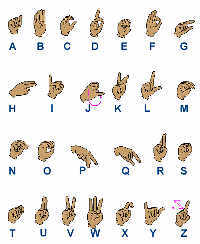- State Resources
- » 50 States
- » Maine
- » Symbols
Maine State Language of the Deaf Community
American Sign Language

Adopted in 1991
American sign language is the official state language of the deaf community adopted in 1991.
A sign language (also signed language) is a language which uses manual communication instead of sound to convey meaning - simultaneously combining handshapes, orientation and movement of the hands, arms or body, and facial expressions to express fluidly a speaker's thoughts. Sign languages commonly develop in deaf communities, which can include interpreters and friends and families of deaf people as well as people who are deaf or hard of hearing themselves. They are also used by people with speech impairments such as Aphasia.
Maine State Language of the Deaf Community: American Sign Language
American Sign Language (ASL) is the predominant sign language of deaf communities in the United States and English-speaking parts
of Canada. Besides North America, dialects of ASL and ASL-based creoles are used in many countries around the world, including much of West Africa
and parts of Southeast Asia. ASL is also widely learned as a second language, serving as a lingua franca. ASL is most closely related to French Sign
Language (FSL). It has been proposed that ASL is a creole language, although ASL shows features atypical of creole languages, such as agglutinative
morphology.
ASL originated in the early 19th century in the American School for the Deaf (ASD) in Hartford, Connecticut, from a situation of language contact.
Since then, ASL use has propagated widely via schools for the deaf and deaf community organizations. Despite its wide use, no accurate count of ASL
users has been taken, though reliable estimates for American ASL users range from 250,000 to 500,000 persons, including a number of children of deaf
adults. ASL users face stigma due to beliefs in the superiority of spoken language to signed language, compounded by the fact that ASL is often glossed
in English due to the lack of a standard writing system.
ASL signs have a number of phonemic components, including movement of the face and torso as well as the hands. ASL is not a form of pantomime, but
iconicity does play a larger role in ASL than in spoken languages. English loan words are often borrowed through fingerspelling, although ASL grammar
is unrelated to that of English. ASL has verbal agreement and aspectual marking, and has a productive system of forming agglutinative classifiers.
Many linguists believe ASL to be a subject-verb-object (SVO) language, but there are several alternative proposals to account for ASL word order.
Maine Law
The law designating the American sign language as the official Maine state language of the deaf community is found in then Maine Revised Statutes, Title 1, Chapter 9, Subchapter 1, Section 220.
Title 1: GENERAL PROVISIONS
Chapter 9: SEAL, MOTTO, EMBLEMS AND FLAGS
Subchapter 1: GENERAL PROVISIONS
§220. Official state language of the deaf community
American sign language is the official state language of the deaf community. [1991, c. 279, §2 (NEW).]
SECTION HISTORY
RR 1991, c. 2, §1 (RNU). 1991, c. 279, §2 (NEW).








